Abstract
Escherichia coli grew anaerobically on a minimal medium with glycerol as the carbon and energy source and dimethyl sulfoxide (DMSO) as the terminal electron acceptor. DMSO reductase activity, measured with an artificial electron donor (reduced benzyl viologen), was preferentially associated with the membrane fraction (77 +/- 10% total cellular activity). A Km for DMSO reduction of 170 +/- 60 microM was determined for the membrane-bound activity. Methyl viologen, reduced flavin mononucleotide, and reduced flavin adenine dinucleotide also served as electron donors for DMSO reduction. Methionine sulfoxide, a DMSO analog, could substitute for DMSO in both the growth medium and in the benzyl viologen assay. DMSO reductase activity was present in cells grown anaerobically on DMSO but was repressed by the presence of nitrate or by aerobic growth. Anaerobic growth on DMSO coinduced nitrate, fumarate, and and trimethylamine-N-oxide reductase activities. The requirement of a molybdenum cofactor for DMSO reduction was suggested by the inhibition of growth and a 60% reduction in DMSO reductase activity in the presence of 10 mM sodium tungstate. Furthermore, chlorate-resistant mutants chlA, chlB, chlE, and chlG were unable to grow anaerobically on DMSO. DMSO reduction appears to be under the control of the fnr gene.
Full text
PDF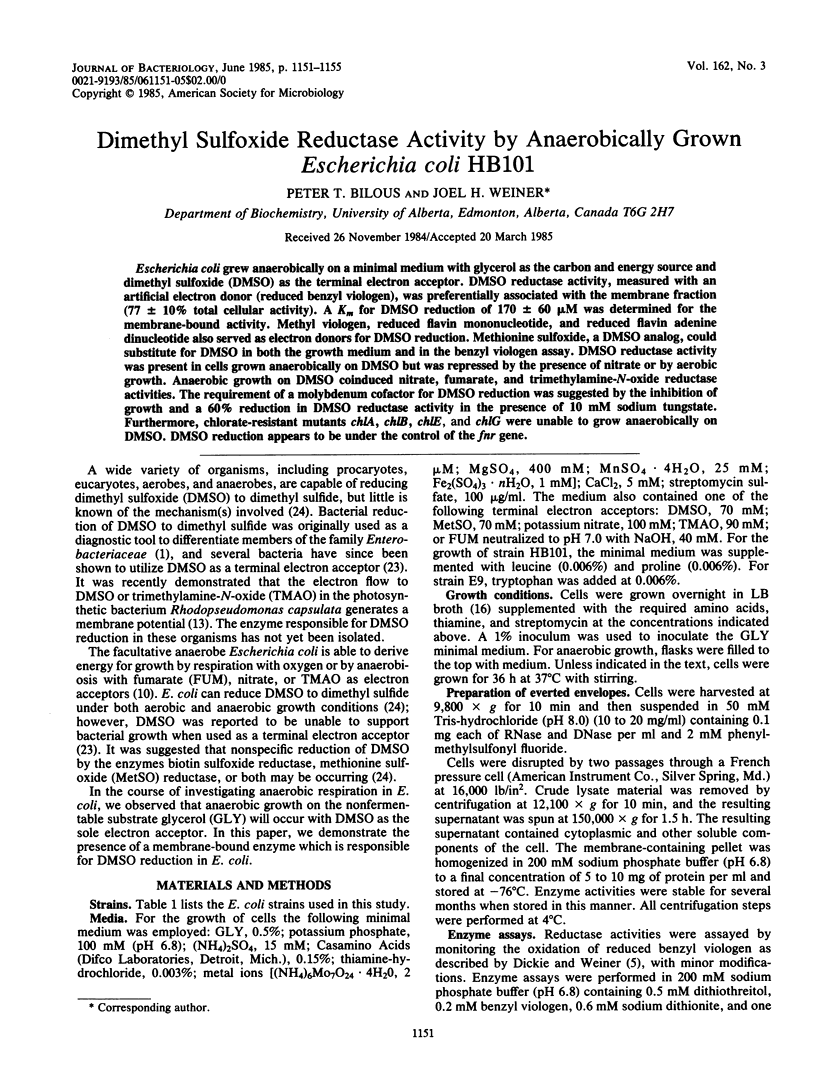
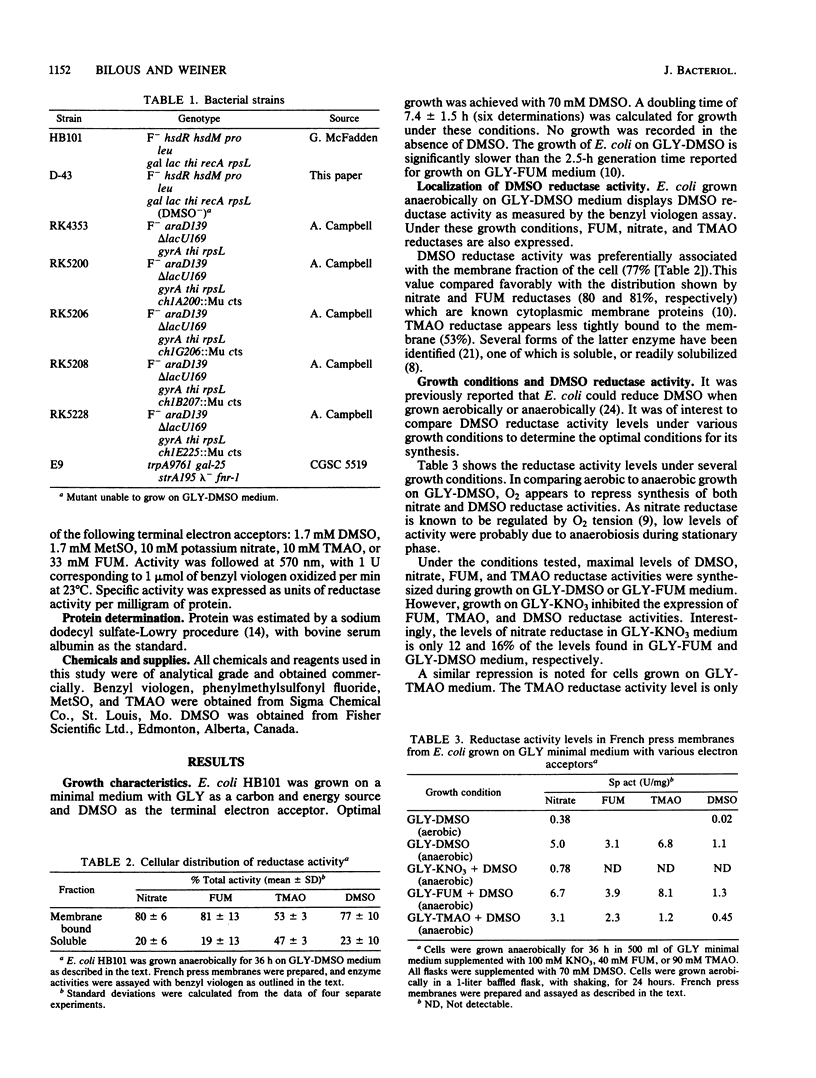
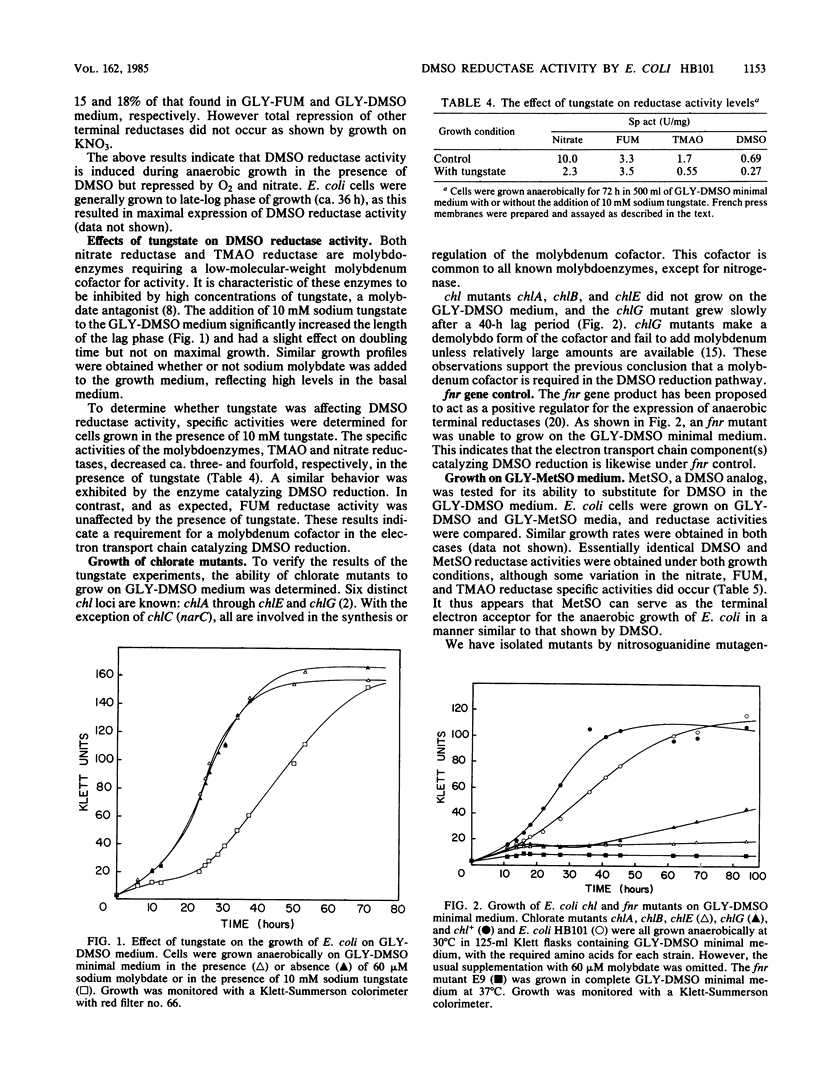
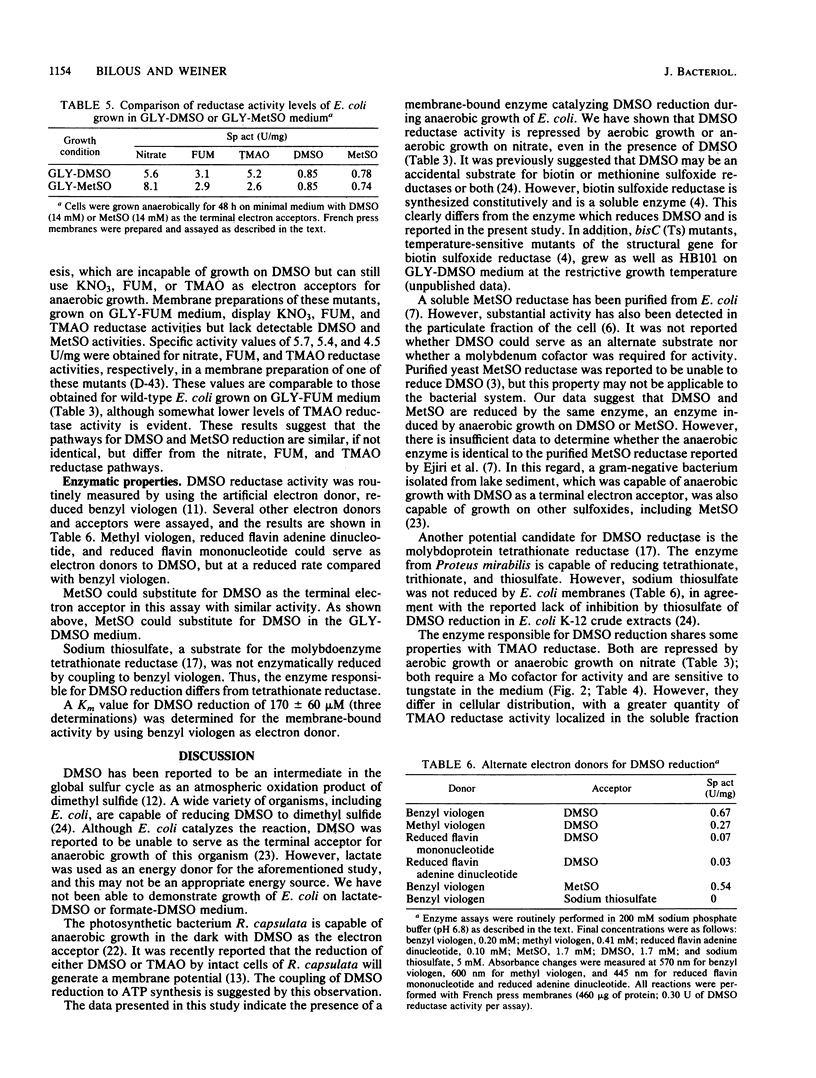
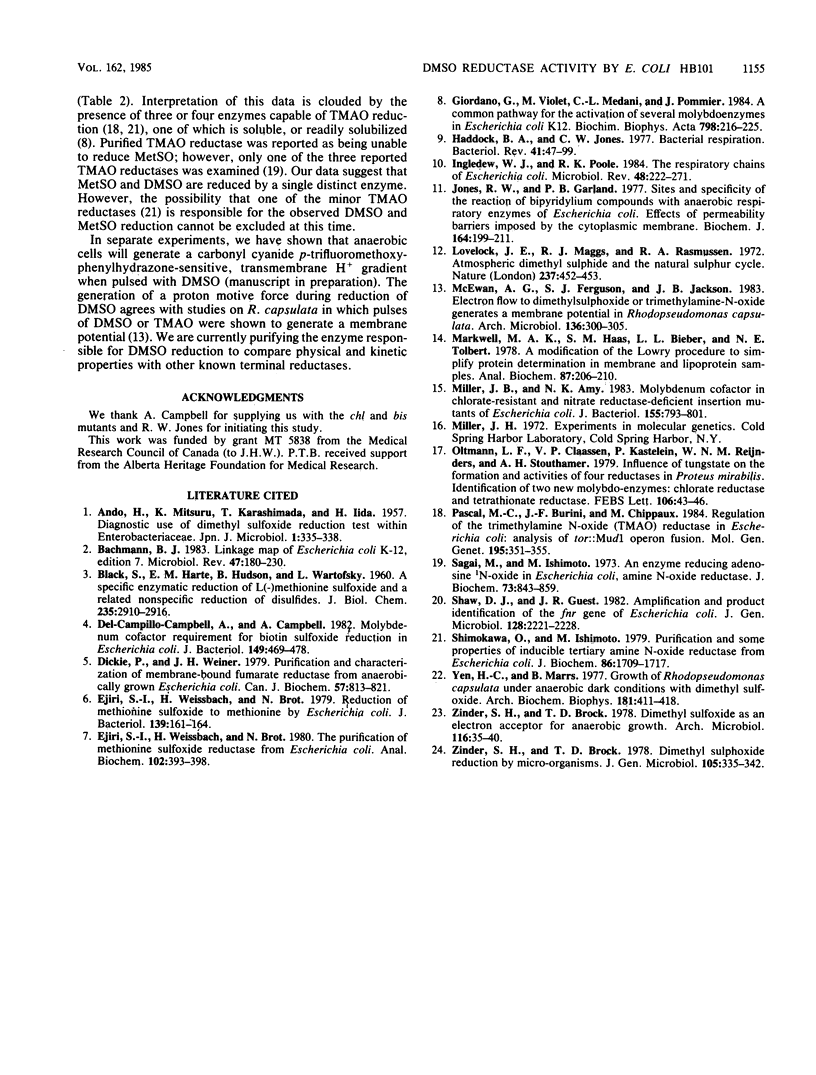
Selected References
These references are in PubMed. This may not be the complete list of references from this article.
- ANDO H., KUMAGAI M., KARASHIMADA T., IIDA H. Diagnostic use of dimethylsulfoxide reduction test within Enterobacteriaceae. Jpn J Microbiol. 1957 Oct;1(4):335–338. doi: 10.1111/j.1348-0421.1957.tb00032.x. [DOI] [PubMed] [Google Scholar]
- Bachmann B. J. Linkage map of Escherichia coli K-12, edition 7. Microbiol Rev. 1983 Jun;47(2):180–230. doi: 10.1128/mr.47.2.180-230.1983. [DOI] [PMC free article] [PubMed] [Google Scholar]
- Dickie P., Weiner J. H. Purification and characterization of membrane-bound fumarate reductase from anaerobically grown Escherichia coli. Can J Biochem. 1979 Jun;57(6):813–821. doi: 10.1139/o79-101. [DOI] [PubMed] [Google Scholar]
- Ejiri S. I., Weissbach H., Brot N. Reduction of methionine sulfoxide to methionine by Escherichia coli. J Bacteriol. 1979 Jul;139(1):161–164. doi: 10.1128/jb.139.1.161-164.1979. [DOI] [PMC free article] [PubMed] [Google Scholar]
- Ejiri S. I., Weissbach H., Brot N. The purification of methionine sulfoxide reductase from Escherichia coli. Anal Biochem. 1980 Mar 1;102(2):393–398. doi: 10.1016/0003-2697(80)90173-6. [DOI] [PubMed] [Google Scholar]
- Giordano G., Violet M., Medani C. L., Pommier J. A common pathway for the activation of several molybdoenzymes in Escherichia coli K12. Biochim Biophys Acta. 1984 Apr 10;798(2):216–225. doi: 10.1016/0304-4165(84)90307-6. [DOI] [PubMed] [Google Scholar]
- Haddock B. A., Jones C. W. Bacterial respiration. Bacteriol Rev. 1977 Mar;41(1):47–99. doi: 10.1128/br.41.1.47-99.1977. [DOI] [PMC free article] [PubMed] [Google Scholar]
- Ingledew W. J., Poole R. K. The respiratory chains of Escherichia coli. Microbiol Rev. 1984 Sep;48(3):222–271. doi: 10.1128/mr.48.3.222-271.1984. [DOI] [PMC free article] [PubMed] [Google Scholar]
- Jones R. W., Garland P. B. Sites and specificity of the reaction of bipyridylium compounds with anaerobic respiratory enzymes of Escherichia coli. Effects of permeability barriers imposed by the cytoplasmic membrane. Biochem J. 1977 Apr 15;164(1):199–211. doi: 10.1042/bj1640199. [DOI] [PMC free article] [PubMed] [Google Scholar]
- Markwell M. A., Haas S. M., Bieber L. L., Tolbert N. E. A modification of the Lowry procedure to simplify protein determination in membrane and lipoprotein samples. Anal Biochem. 1978 Jun 15;87(1):206–210. doi: 10.1016/0003-2697(78)90586-9. [DOI] [PubMed] [Google Scholar]
- McEwan A. G., Ferguson S. J., Jackson J. B. Electron flow to dimethylsulphoxide or trimethylamine-N-oxide generates a membrane potential in Rhodopseudomonas capsulata. Arch Microbiol. 1983 Dec;136(4):300–305. doi: 10.1007/BF00425221. [DOI] [PubMed] [Google Scholar]
- Miller J. B., Amy N. K. Molybdenum cofactor in chlorate-resistant and nitrate reductase-deficient insertion mutants of Escherichia coli. J Bacteriol. 1983 Aug;155(2):793–801. doi: 10.1128/jb.155.2.793-801.1983. [DOI] [PMC free article] [PubMed] [Google Scholar]
- Oltmann L. F., Claassen V. P., Kastelein P., Reijnders W. N., Stouthamer A. H. Influence of tungstate on the formation and activities of four reductases in Proteus mirabilis: identification of two new molybdo-enzymes: chlorate reductase and tetrathionate reductase. FEBS Lett. 1979 Oct 1;106(1):43–46. doi: 10.1016/0014-5793(79)80691-2. [DOI] [PubMed] [Google Scholar]
- Pascal M. C., Burini J. F., Chippaux M. Regulation of the trimethylamine N-oxide (TMAO) reductase in Escherichia coli: analysis of tor::Mud1 operon fusion. Mol Gen Genet. 1984;195(1-2):351–355. doi: 10.1007/BF00332770. [DOI] [PubMed] [Google Scholar]
- Sagai M., Ishimoto M. An enzyme reducing adenosine 1N-oxide in Escherichia coli, amine N-oxide reductase. J Biochem. 1973 Apr;73(4):843–859. doi: 10.1093/oxfordjournals.jbchem.a130147. [DOI] [PubMed] [Google Scholar]
- Shaw D. J., Guest J. R. Amplification and product identification of the fnr gene of Escherichia coli. J Gen Microbiol. 1982 Oct;128(10):2221–2228. doi: 10.1099/00221287-128-10-2221. [DOI] [PubMed] [Google Scholar]
- Shimokawa O., Ishimoto M. Purification and some properties of inducible tertiary amine N-oxide reductase from Escherichia coli. J Biochem. 1979 Dec;86(6):1709–1717. doi: 10.1093/oxfordjournals.jbchem.a132691. [DOI] [PubMed] [Google Scholar]
- Yen H. C., Marrs B. Growth of Rhodopseudomonas capsulata under anaerobic dark conditions with dimethyl sulfoxide. Arch Biochem Biophys. 1977 Jun;181(2):411–418. doi: 10.1016/0003-9861(77)90246-6. [DOI] [PubMed] [Google Scholar]
- Zinder S. H., Brock T. D. Dimethyl sulfoxide as an electron acceptor for anaerobic growth. Arch Microbiol. 1978 Jan 23;116(1):35–40. doi: 10.1007/BF00408731. [DOI] [PubMed] [Google Scholar]
- Zinder S. H., Brock T. D. Dimethyl sulphoxide reduction by micro-organisms. J Gen Microbiol. 1978 Apr;105(2):335–342. doi: 10.1099/00221287-105-2-335. [DOI] [PubMed] [Google Scholar]


